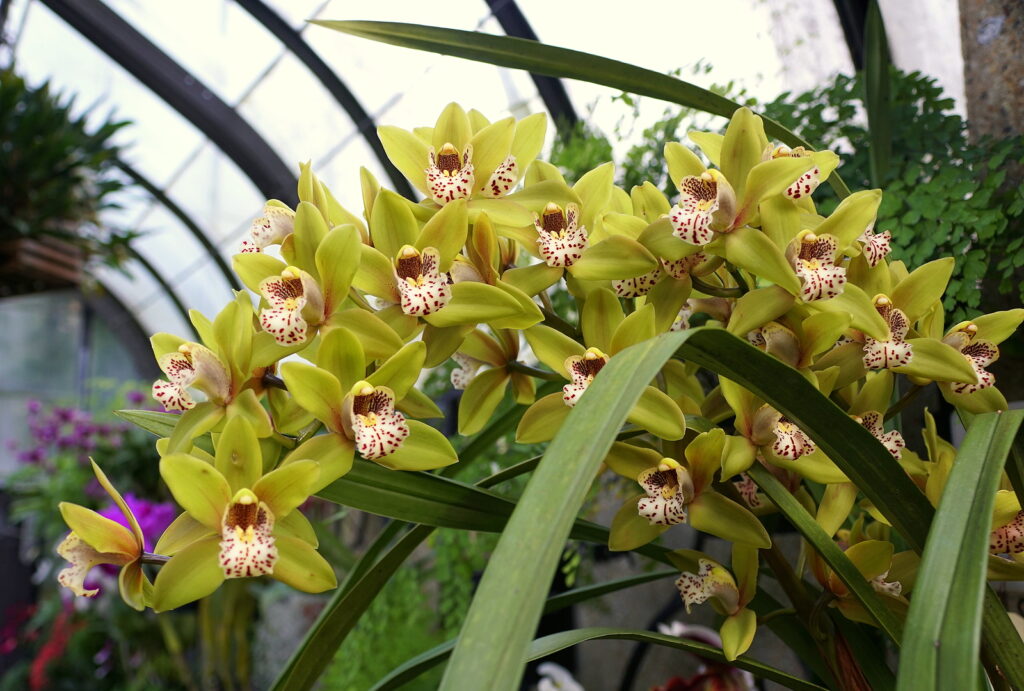Epidendrum is a large genus of terrestrial or epiphytic orchids that are easily grown, and produce compact clusters of small, sweetly scented flowers that last up to several months on the plant.
Epidendrum is a genus of more than 1,000 species. Some have pseudobulbs or thickened stems, others having canelike stems. Epidendrums with reed-like stems tend to grow too tall for indoor cultivation; they are good garden plants in tropical and subtropical climates. Epidendrums species and hybrids with pseudobulbs are often grown indoors.
Get to know Epidendrum
- Plant type: Epiphytic or terrestrial orchid
- Growing zones and range: Zones 12-15
- Hardiness: Hardy to Zone 12
- Optimal growing temperature: day, 70° to 85°F (21° to 29°C); night, 60° to 65°F (16° to 18°C).
- Height and width: 8 to 36 inches (20cm-1m) tall and 6 to 20 inches (15-30cm) wide
- Foliage: Some species have thick, leathery leaves, others have reed-like leaves
- Flowers: Clusters of blooms produced in terminal, umbel-like racemes or panicles
- Bloom time: Summer
- Uses: Houseplant, tropical garden
- Common name: Buttonhole orchid
- Botanical name: Epidendrum
- Family name: Orchidaceae
- Origin: Tropical North, Central, and South America

Where to plant Epidendrum
- Light: Plants with pseudobulbs require bright light from southern exposure; shade from summer sun at midday. Plants with canelike stems lacking pseudobulbs require slightly more shade. Smaller plants do well under artificial light, needing 12 to 16 light-hours daily. Good circulation of fresh air.
- Soil: Pot Epidendrum in Osmunda fiber or orchid bark mix.
When to plant Epidendrum
- Set Epidendrum outdoors any time of the year in tropical and subtropical climates.
Planting and spacing Epidendrum
- Space Epidendrum 6 to 20 inches (15-30cm) or more apart depending on the variety.
How to water and feed Epidendrum
- Water: Allow plants with pseudobulbs to become nearly dry between waterings. Plants with canelike stems should be kept moist, not wet, year-round. Mist foliage often. Humidity at 50% is best.
- Feeding: Feed Epidendrum quater-strength fertilizer every third watering during active growth.
Epidendrum care
- Reed-stemmed species need much sun to flower but also coolness and shade at the roots. Mulch around these plants if they are growing in the ground.
- Reed-stemmed species growing in cold winter regions should be grown in pots and moved indoors in winter where temperatures fall to 22°F (-6°C).
- When flowers fade, cut the flower stem back to within one or two joints above the soil.
- Species with canes can be trained on a tree-fern pole or staked.
Growing Epidendrum as a houseplant
- Epidendrum prefers direct or bright light, high humidity, and cool to average temperature.
- Grow Epidendrum in a potting mix made for orchids, or a standard soulless mix with additional unmilled sphagnum moss, fir or redwood bark, or osmunda fiber.
- Keep the medium evenly moist when the plant is growing and blooming; at other times, allow it to dry out between waterings.
- Fertilize Epidendrum monthly when the plant is growing or flowering; use a complete fertilizer.
Epidendrum pests and diseases
- Spider mites, mealybugs, whiteflies, and aphids can attack Epidendrium.
- Black rot, leaf spots, virus diseases, and rust can occur.
Epidendrum propagation
- Divide Epidendrum when the plants overflower their containers.
- Remove plantlets from plants with canelike stems, or take stem cuttings.
Epidendrum varieties to grow
- Epidendrum atropurpureum, spice orchid. Pseudobulbous plant; bears an erect or arching flower stalk bearing 4 to 20 flowers, colored brown with apple green edging; lip is white with rosy spot; flowers in spring.
- E. difforme. Grows to 20 inches (50cm) tall and 12 inches (30m) wide; canelike stems; flowers are waxy and pale green; blooms in midwinter.
- E. fragrans. Small pseudobulbous plant, features 2 to 5 richly fragrant flowers on a short stem; blooms are cream colored; lip is shaped like a shell and striped with purple; blooms from summer to fall.
- E. ibaguense, native to Colombia, shoots up to 2 or even 4 feet high with canelike, leafy stems (it has no pseudobulb). Orange yellow flowers bloom in dense clusters at various times during the year. Numerous hybrids offer flowers of yellow, orange, pink, red, lavender, and white.
- E. mariae reaches about 8 inches when in bloom. The 3-inch green flowers have broad white lips. Best grown on a slab of bark in bright light. Several named varieties exist; E.m. ‘Doris’ is a favorite.
- E. nemorale grows to 16 inches from a pseudobulb, bearing 4-inch rose and purple flowers in spring and summer.
- E. stamfordianum, growing to 2 ½ feet from a pseudobulb, produces tiny red and yellow flowers in spring.
- E. tampense, butterfly orchid. Pseudobulbous plant; bears long sprays of delicate flowers; blooms are yellow-green tinged with brown; lip is white with purple spot.



